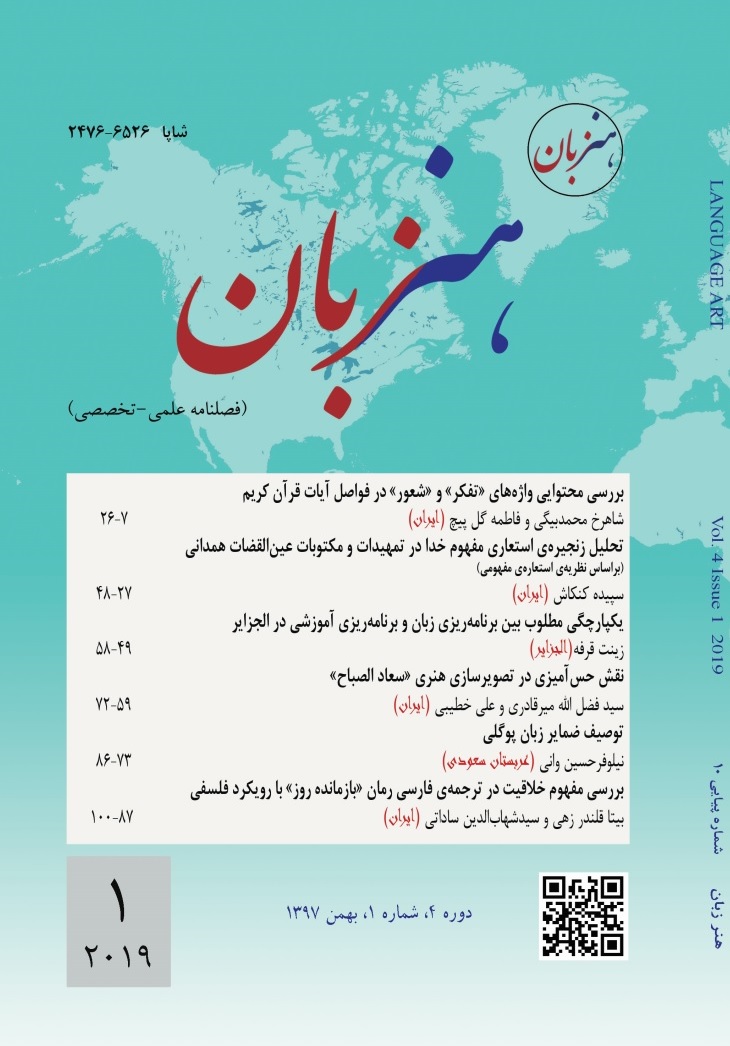تحلیل زنجیرة استعاری مفهوم خدا در تمهیدات و مکتوبات عینالقضات همدانی
DOI:
https://doi.org/10.22046/LA.2019.02الكلمات المفتاحية:
خدا، حضرت محمد(ص)، قرآن، ابلیس، عشق، نگاشت، استعارههای مفهومی.الملخص
عرفا برای بیان آرا و عقاید و تجربههای شهودی خود از انواع شگردهای بیانی و ظرفیتهای مختلف زبانی استفاده میکنند. عناصر خیال در آثار عرفانیِ ناب مولود تجربههای شخصی است و جنبۀ آرایه و زینت کلام ندارند بهطوریکه میتوان گفت با مفاهیم عرفانی پیوند ذاتی دارند. گاه کثرت کاربرد و تکرار این عناصر در یک اثر ما را به طرز تفکر و شیوهای از فرایند شناختی صاحب اثر رهنمون میشود. بهعبارت دیگر، این عناصر خیال در نگاهی وسیعتر، جنبههایی از نوعی نظام فکری و اندیشگانی خاص را نمایان میکنند. در این نگاه کارکرد آنها ازسطح لفظ و جمله فراتر میرود و درسطح اندیشه و باعنوان «استعارههای مفهومی» یا «استعارههای شناختی» مطرح میشوند. در دو اثر فارسیِ «تمهیدات» و «مکتوبات» عینالقضات همدانی مفهوم خدا و بهتبع آن مفاهیمی چون حضرت محمد(ص)، قرآن، ابلیس، عشق و... نوعی از حوزههای مفهومی و معنایی هستند که با مجموعۀ تناظرهای خود در قلمروهای حسی و ملموس، درقالب استعارههای مفهومی «خدا سلطان است»، «خدا محبوب است»، «خدا نور و آفتاب است» و «خدا کاتب است» و «خدا جنگجو و مبارز است» شناخته میشوند.المراجع
Ayn al-Quzat Hamadani, A. (1983). nāmehā, emended by: Afif Asairan & Ali Naghi Monzavi, 2nd Ed., Tehran: Manouchehri.
Ayn al-Quzat Hamadani, A. (2010). tamhidāt, emended by: Afif Asiran, 8th Ed., Tehran: Manouchehri.
Behnam, M. (2010). Study of conceptual metaphor of Light in the Divan-e-Shams, Literary Criticism, Vol. 3, No. 10, pp. 91-114.
Fouladi, A. (2010). The Language of Mysticism, Tehran: Sokhan.
Hashemi, Z. (2010). Conceptual Metaphor Theory as Proposed by Lakoff and Johnson, Journal of Persian Language & Literature, Vol. 4, No. 12, pp. 140-199.
Hashemi, Z. (2013). The Chains of Love (Mohabat) in Sufism (The Study of Sight Sofis about Love (Mohabat) since 2th-6th Based on Conceptual Metaphor Theory), Literary Criticism, Vol. 6, No. 22, pp. 29-48.
Hashemi, Z. (2015). ʔeʃqe sufiyāne dar ʔāyineye ʔesteʔāre, Tehran: Elmi.
Lakoff, G. & et. al. (2013). ʔesteʔāre: mabnāye tafakkor va zibāyi ʔāfarini, Translated by: Farhad Sasani & e. al., 2nd Ed., Tehran: Soureye Mehr.
Lewisohn, L. (2005). Heritage of Sufism, Translated by: Majdeddin Keivani, Tehran: Markaz.
Mirbagherifard, S. A. & Sh. Niyazi. (2010). barrasi va tahlile zabāne ʔerfāni dar ʔāsāre ʔayn ʔalqozāte hamedāni, The Journal of Philosophical-Theological Research, vol. 12, Autumn & Winter 2010, Nos. 1 & 2, pp. 267-286.
Mohabbati, M. (2009). taʔvile bi xiʃtan nevisi: tahlili tāze ʔaz negarehāye ʔadabiye ʔayn ʔalqozāte hamedāni, Literary Criticism, Vol. 2, No. 8, pp. 53-79.
Monzavi, A. (1983). moqadameʔi bar nāmehāye ʔayn ʔalqozāte hamedāni, 3rd Vol., Tehran: Monouchehri.
Pourjavady, N. & et. al. (2014). The History and Geography of Sufism, 2nd Ed., Tehran: Nashre Ketabe Marjaa.
Pournamdarian, T. (2007). ramz va dāstānhāye ramzi dar ʔadabe pārsi, 5th Ed., Tehran: Elmi Farhangi.
Safa, Z. (1990). The History of Literature of Iran, 1st Vol., Tehran: Ferdows.
Samadiani, Gh. (2015). barrasiye taǰrobehāye ʔerfāni dar tamhidāt bar ʔasāse feʔl bā taʔkid bar ruykarde naqʃgarā, Journal of Letters & Language, Vol. 18, No. 37, pp. 167-187.
Sattari, J. (2007). Love in Sufism, 5th Ed., Tehran: Markaz.
Shafiei Kadkani, M. (2013). zabāne ʃeʔr dar nasre sufie, 4th Ed., Tehran: Sokhan.
Stiver, D. (2001). The Philosophy of Religious Language: Sign, Symbol, and Story, Translated by: Hussein Nowrouzi, Research Institute for Humanities & Islamic Sciences, Tabriz University.
Toshihiko, I. (2015). Sufism and Taoism: A Comparative Study of Key Philosophical Concepts, Translated by: Mohammadjavad Gohari, Tehran: Aban.

